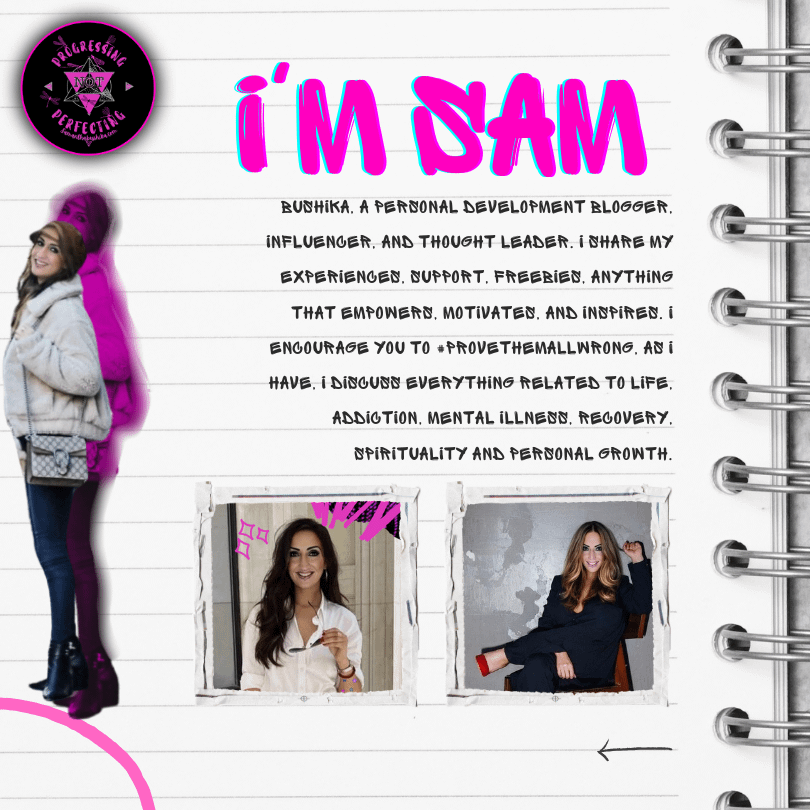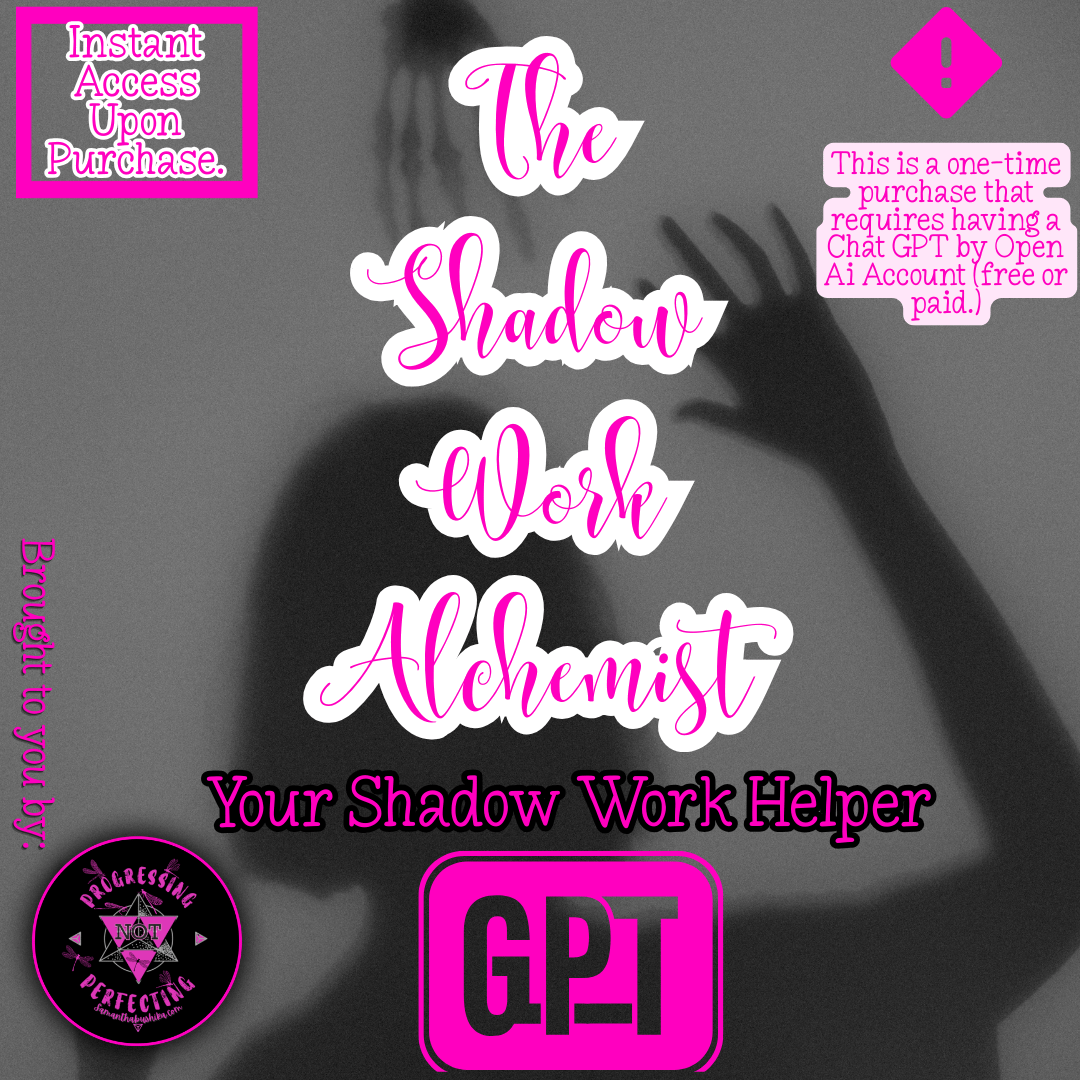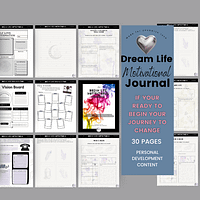 Understanding our shadow is essential in creating self-awareness.
Understanding our shadow is essential in creating self-awareness. Shadow work is a profound and transformative process that involves exploring the hidden aspects of your personality—those deep-seated fears, insecurities, and unresolved emotions that reside in the unconscious mind. The benefits of shadow work are nothing short of life-changing, and I can personally attest to its power. By confronting your shadow side, you can uncover a deeper understanding of yourself, which can lead to personal growth and break free from negative patterns that have held you back. If you’re curious about this journey and want to embark on a transformative practice, along with a sixteen-week, 136-page shadow work journaling PDF, keep reading.
My Journey into the Shadows
The Universe has dragged me, kicking and screaming, into the world of shadow work. As someone who prefers to “live in the here and now,” I was initially resistant.
I thought it was best to let sleeping dogs lie. However, about two months into my shadow work journey, I realized that Carl Jung, the renowned Swiss psychiatrist, and psychoanalyst, knew exactly what he was talking about. You might be wondering, what is shadow work? Let’s dive in.
Carl Jung and the Concept of Shadow Work
Carl Jung coined the term “shadow work” to describe the therapeutic process of accepting and integrating one’s shadow parts—those repressed aspects of our psyche. According to Jungian psychology, this integration enables us to express our true self and creativity more fully. Shadow work involves facing the darker aspects of ourselves that we’ve been avoiding, allowing us to become whole once again. By engaging in this inner work, we gain profound self-awareness, breaking down psychological barriers that have hindered our personal development. This process requires confronting our fears, acknowledging our shadow traits, and embracing our deepest, often hidden, emotions as part of our authentic self.
Jung emphasized that these shadow aspects often include negative traits, such as greed, fearfulness, or cruelty—elements of our dark side. These traits do not make us “bad” people; instead, they offer opportunities for self-reflection and learning.
Without accepting and acknowledging our shadow selves, achieving true personal growth is nearly impossible. Jung famously stressed that shadow work is essential for psychological development, referring to it as an awakening of the shadow parts of our personality that have long remained hidden.
Understanding and Embracing Your Shadow
Shadow work is a journey best undertaken when youare mentally sound and stable—it’s not recommended during early recovery from addiction or trauma. Educating yourself about the concept of the shadow self and waiting until you’re in a long-term recovery phase is crucial. Through shadow work, you can recognize the unconscious thoughts and patterns that keep you stuck in negative behaviors and break free from them.
Understanding and accepting your inner shadow is essential for cultivating greater self-awareness, self-mastery, and compassion. By exploring the hidden parts of your personality, you can develop a deeper connection with your inner self and gain a clearer understanding of your emotional triggers.
This process of integration allows us to reclaim those repressed parts of ourselves, leading to a more profound understanding and acceptance of our whole selves.
The Benefits of Shadow Work
Working through shadow traits can be emotionally and psychologically intense. It may be necessary to seek guidance from mental health professionals, such as a licensed clinical psychologist or Jungian analyst, especially when dealing with childhood traumas or deeply ingrained unconscious aspects. Numerous resources, including books, articles, and shadow work exercises, are available to help you navigate this difficult process.
At the end of this post, I’m offering a FREE sixteen-week, 136-page Shadow Work Prompt Journal designed specifically for my readers. Every page is beautifully detailed, with spaces for you to write or type your reflections. This journal is to be done one prompt a day over 16-weeks.
Carl Jung believed that shadow work is one of the most important steps toward personal and spiritual growth, and I have to say I agree. By confronting our inner shadow figure, we can achieve a deeper understanding of ourselves and our emotions.
According to Jung’s theory of individuation, acknowledging and embracing the shadow archetype is necessary to attain true enlightenment. He challenged the traditional idea that we must deny our “dark” side to be spiritual, insisting instead that only through the process of shadow work can all aspects of the personality be acknowledged, accepted, and unified.
This unification leads to a sense of wholeness and understanding, which is essential for overall personal growth and development. While the concept of shadow work can be uncomfortable, it is a great way to achieve greater self-awareness, personal development, and a sense of empowerment. Shadow work can take many forms, from shadow work journaling and meditation to therapy and support groups.
Breaking Free from Limiting Beliefs
The goal of shadow work is to be open and honest with yourself as you explore your shadow selves. This powerful technique for personal transformation and self-discovery requires bravery, openness, and a willingness to confront these darker parts of ourselves.
The process can lead to greater self-awareness, healthier relationships, and a sense of inner peace. While shadow work is hard work, the rewards are worth it—increased emotional intelligence, greater personal power, and a stronger connection with our full potential.
Engaging in shadow work can also help us break free from limiting beliefs and behaviors that no longer serve us, allowing us to live more fulfilling lives. With greater awareness of our personal shadow, we can also better understand the shadows within our communities and society at large, leading to greater social responsibility and activism.
Overall, shadow work is a great tool for living a more authentic life, with a deeper sense of purpose and clarity. By using the free shadow work journal PDF, you can explore your shadow aspects over the next sixteen weeks, guiding you toward your best version.
How to Begin Your Shadow Work Journey
Before embarking on shadow work, approach the practice with self-compassion and without judgment. Set aside dedicated time and space for exploring your inner world. Be sure to print or download the free shadow work journal PDF.
It can be helpful to journal your thoughts and feelings, or engage in creative pursuits like art or music to access the unconscious aspects of your psyche.
Notice patterns in your behavior, relationships, and strong reactions to certain situations or people. Pay attention to any strong emotions that arise when reflecting on these experiences, as they can offer valuable insight into internal conflicts or unresolved issues.
Seek support from a therapist or trusted friend if necessary during this process. Remember, shadow work is a journey, not a destination. Be patient with yourself as you explore the depths of your human psyche using my shadow work journal.
The Importance of Shadow Work in Addiction Recovery

By doing our shadow work, we can better understand the root causes behind our addictions, helping us to uncover the underlying reasons for our struggles and ultimately find the inner strength to overcome substance abuse.
Shadow work offers a path to healing that goes beyond physical abstinence, addressing the emotional and psychological wounds that drive addictive behaviors.
Exploring the Root Causes of Addiction
Childhood wounds and trauma are often at the root of addiction. Experiences such as neglect, abuse, or the loss of a primary caregiver can create deep emotional scars that individuals may try to numb with addictive behaviors.
The shadow work journal PDF can help you explore these experiences further. By acknowledging and processing these past traumas, you may begin to understand why you turned to addiction in the first place and develop healthier coping mechanisms moving forward.
Shifting your perspective on addiction and exploring positive aspects that reinforce sobriety is crucial. Addiction recovery involves more than just quitting a substance or behavior; it requires inner work to shift your mindset and develop positive habits that support sobriety.
Use shadow work prompts like: What positive changes have you experienced since getting sober? What are some healthy activities that bring joy into your life? How can you create new positive memories to replace those associated with addiction?
By exploring these prompts, you can shift your mindset towards living a healthier and happier life without addictive behaviors.
Carl Jung’s Four Steps to Shadow Work
Shadow work can be understood as a four-step process:
- Identification: Learn to recognize the parts of your personality that lie in your shadow. For example, if you experienced abandonment at an early age, like I did, you might have unconsciously repressed those feelings, which then influenced your behavior in adulthood.
- Acknowledgment: Accept and explore the hidden aspects of yourself with an open mind. Acknowledge the impact of past traumas, such as abandonment or anger, and understand how these experiences have shaped your shadow self.
- Analysis: Start to understand the underlying energies behind these aspects. This might involve revisiting painful memories or childhood experiences to gain insight into your subconscious mind and the origins of your shadow traits.
- Integration: Consciously incorporate these newfound discoveries into your personal and creative life. This is where you begin to embrace your full self, including both the positive and negative aspects of your personality, leading to profound self-awareness and growth.
Further Exploration
Identification
You must identify the parts of you that you unconsciously repress. Let me give you an example. My last post was about how I lived my entire life trying not to feel abandoned after I went home one day when I was barely a teenager to find that everything in my apartment was gone except for my bedroom. My mom had taken my little sister, had moved out of state, and left no forwarding address.
If anyone knows what real abandonment feels like, you know that it seeps into every aspect of your existence. When you deny the feeling, it gets so much worse. I liken it to trying not to obsessively think about something you are obsessively thinking about. Before long, I had picked up heroin because I never felt right.
Who would feel right after being left and abandoned at fourteen or fifteen years old? I have come to call my issues with abandonment, people pleasing, and lack of appropriate boundaries when it comes to helping those less fortunate the “my mommy never loved me” syndrome.
Acknowledgment
No, I have never blamed my addiction on anyone or anything except myself. I refuse to be a victim, remember? After working through my issues in my shadow work, I am now able to reflect and see why my feelings were completely valid, and one night of bawling my eyes out was not enough. Identify the issues that you know you have repressed by looking at your past and current behaviors and writing them down so you can address them one by one. It’s so worth it. I promise.
This is not for the faint of heart. After you identify any issues that you may have, you will need to revisit certain experiences that you lived through that may be at the root of how the behavior came to be.
Look at the list that you have identified as problems in your current life, then pick out the ones that are the biggest struggle for you or that affect your day-to-day life the most. My advice is to start with the most problematic behavior.
Side Note
For instance anger, we all struggle with some degree of what would be healthy anger. If you spent your childhood being angry because you had to repeatedly watch your mother be abused by a slew of men, and every time you got angry and tried to defend your mom, you would be yelled at by your mom, and she may have told you that you were bad and/or awful.
Over time you would stop trying to defend her, but you were still forced to watch it over and over. You suppressed the anger that was welling up inside of you. Little did you know that you were making your shadow big and fat.
You may have also begun to develop opinions or biases against men because it happened with every single one of them. These emotions that you felt were completely normal, and as an adult, you now know that on a conscious level.
You must acknowledge it on both a conscious and subconscious level with no judgment, and you must acknowledge before you and your shadow-self that it was safe and healthy to express your emotions and that you know that he/she/others was only trying to help.
You are allowed to feel angry. Start by acknowledging the events/experiences that need to be revisited. Look at your triggers regarding what sets you off before the unwanted behavior manifests.
Analysis
In my experience, acknowledgment and analysis went hand in hand. Except I discovered a lot of things that I had forgotten. While revisiting some of my experiences, I came across one of my old, very loved childhood “stuffy” that I had adored as a child. It was almost like cleaning out my attic and finding an old book that I had once read a hundred times.
Snowflake had been hiding in the dark recesses of my mind, misfiled along with the rest of my good, though sparse, childhood memories.
My advice is to be mentally prepared. Don’t start this journey if you aren’t ready to do the work. If you are not at a stable place in your life or your recovery, then do not proceed.
You just don’t know what’s hidden in the dark recesses of your mind, and if you aren’t prepared to handle doing whatever it takes to move forward and be whole, then wait.
No doubt is permitted. For me, it wasn’t and hasn’t been even half as bad as I suspected, and I not only found a beautiful part of me that I didn’t know existed, but I found things like Snowflake.
Integration
I will tell you how I did this, and it was pretty easy to get the ball rolling. I went to YouTube and found a few really good shadow work meditations, which you can find here and here. Don’t think you can’t meditate because I suffer with ADHD, and I recently found out I have Aphantasia.
I seriously cannot visualize, and I still made it work. Complete one of the meditations and see how you feel. Wait a few days and see what rolls in. Keep track of any thoughts that might occur, even if they don’t make sense at the time. It will often make sense with some distance.
How to Incorporate Shadow Work Prompts into Your Daily Routine
Incorporating shadow work prompts into your daily routine is essential for achieving lasting change. Set aside time each day for self-reflection in a safe space where you won’t be disturbed. Start by reviewing the shadow work journal PDF and choose a prompt that resonates with you.
Write your answers in your journal, exploring your thoughts and emotions without self-judgment. Over time, you’ll start to notice patterns or themes that offer deep insights into your inner life. This process can help you uncover the root causes of addictive behaviors and guide you toward a more fulfilling, authentic life.
I know most of you hate to hear it, but meditation and deep reflection are crucial for being successful in your shadow work. I have mentioned that for years and years, I was overly resistant to meditation. Now it remains one of my deepest regrets.
If you would like, you can check out my post on how meditation can aid those of us in recovery here. I seriously could have been astral projecting for all this time. Meditation can lead to higher levels of consciousness. It has been confirmed by the CIA here. If you look at page twenty-five, it also makes a reference to manifesting.
This was the missing page that was found in an old barn at The Monroe Institute. If this is something you are into, you can check out my post on how I used the law of attraction to beat my lifelong addiction to heroin here.
Conclusion
Shadow work is not for the faint of heart, but it’s a powerful practice for those willing to do the hard work. Whether you’re seeking personal growth, spiritual growth, or recovery from addiction, shadow work can lead you to a deeper understanding of yourself and the world around you.
Embrace the journey, and use my free shadow work journal PDF as your guide. With patience, persistence, and an open mind, you’ll discover the hidden aspects of your psyche, unlocking your full potential and becoming the best version of yourself.
Post Off Quote
"You can't go back and change the beginning, but you can start where you are and change the ending."
–C.S. Lewis
Post Off Affirmation
It doesn't matter how slowly I go as long as I don't stop. Today I take time for myself.
The Gateway Experience Audio
 I actually purchased the entire Gateway series on hemisync.com. The Gateway audios are the audios that were used to train the CIA to astral project/remote view. If you are interested in these audios, click the button below to learn more. Totally worth it, though they may not work for everyone. If you do all of the tapes in order and are consistent with your practice, you should be in the astral realm in no time at all.
I actually purchased the entire Gateway series on hemisync.com. The Gateway audios are the audios that were used to train the CIA to astral project/remote view. If you are interested in these audios, click the button below to learn more. Totally worth it, though they may not work for everyone. If you do all of the tapes in order and are consistent with your practice, you should be in the astral realm in no time at all.**This is an affiliate link. I get a small commission if you use my link to make the purchase of this product. These cost nothing to you, but help me to keep going.**

Please don’t forget to grab your 16-week shadow work journal PDF. I made it with all of you in mind. You will have to provide your email for my newsletter, but pshhhhh… you have been meaning to subscribe anyway.
Now is the time. I will never ever SPAM you or give out your email. That’s a promise. If this post has you excited about your future, let me know in the comments below.
I also would love to know what you guys think of the shadow work journal PDF. Lol. Hit me with it in the comments. Also, support this blog, so I can keep going by following, liking, subscribing, sharing, and registering for our new judgment-free supportive community.





















Highly intriguing observation 👌👌. Thanks for sharing your tips💙✌️😄
Thanks, Killa!😁
Hahaha you are very welcome🙌😆😃.
Sorry for the late response 😄😄. It looks like I won’t get notifications from your page if you reply. I will have to visit it manually but it’s lovely seeing you Samantha and have a great weekend✌️🤩
Why, thank you, Killa! That is so nice! I checked out your website. Sooo.. cool, like fr. What’s the addy again?
😂 you are super welcome; anytime my friend 🙌🙌.
Wow, thank you Samantha ☺️🥰🌹. I’m happy you liked what you saw; I realized that you visited and I am so grateful for that🤟💞😆
By addy you mean by site’s address?; it is this: https://aktionkilla.wordpress.com/
Your site is wayyyy more evolved than mine. I couldn’t help but wonder how long it must have taken you to do it all. That is an insane amount of amazing content very well done. I had NO idea what went into blogging. I just want to help people, and the Universe kept pulling me this way, but man….. I have so much reverence and respect for bloggers like you because I have had to teach myself SEO, keywords, marketing, etc. and it has been a long and tedious journey with not much for results thus far. Luckily for the world, giving up is not an option. I have lost too many people I have loved to ever give up. Man, the work, though. I have been working 90-hour weeks. I can’t imagine how many hours you have put into your blog, and you have a podcast, correct?
I really love your compliments 😆🤭💯💯, thank you so much ☺️💙💙. Yes my site has a ton of images and posts. At first I wanted to use WordPress.com as my own “self hosted” site and server with my own domain etc, but I didn’t realize that I would actually need “WordPress.org” for that which is a whole other ball game haha. I wanted to primarily post gaming videos and whatnot, but my computer was tooooo weak to even record and capture the kind of content that I wanted LOL. So over time alot of the other things that i’m also into like writing and expressing myself through creativity started to takeover and feature more prominently on the site and things just gradually built up from there hahaha.
Your content is really good to me too. I was actually blown away by how insightful and engaging your posts are, so it means alot to me to hear what you have to say. I believe that eventually you will grow alot too, it’s just that you put out way more content in a shorter space of time than the average blogger so it might seem slow at first but that’s only because of the pace at which you are able to produce content and the admirable depth of quality, time and effort that you put into it. So it’s great to hear that you’re not giving up.
My heart ached when you said that you have lost too many people to give up — that is a drive like no other. I encourage you to keep doing what you do because it’s going to take a while and patience, but you will see the fruits of your labor Samantha. The only thig is that I tend to have a little trouble accessing your site unless I type I go to the exact URL, so I don’t know if it may be actually that that’s affecting your site (accessibility), since usually people can see your posts on their feed and things like that but if they click on it and it doesn’t bring them to your site things like that could actually be what’s affecting the traffic on your end, so accessibility and ways that people may or may not be able to interact with you and your content could be an issue that affects the growth -rate of your site/blog.
Hahaha it would be cool to have a podcast but I don’t currently have one. If I had one, you’d definitely be my first guest 😂😂💙
PS: I tried sending my comment multiple times, but the system kept taking long to submit the post and then it would redirect to an error page 😅
Killa! Thank you so much for making me aware. I just did an audit, and whoa! Not good. What do you use for image compression because you have a lot of photos? I am trying to find a plug-in that will aid me in fixing the long list of 404s, redirects, etc., my site has. I purchased all the top plugins for site security and everything else, but now I got nothing left. I have about a year to figure out the monetizing part of this. Lol. Maybe I will hire another person from Fiver to waste weeks of my time and not get the job done. Lol. I actually sprung for the Blog Growth Engine course by Adam Enfroy, and I can’t tell you how happy I am with that course. I wish I would have taken it ALOT sooner because I spent a lot of time and money on courses that I could have taught myself. I am definitely not in this for the money, but I have to support my kids. I see no reason why I can’t help people and make money. My motives are completely pure, as I mentioned, so that has to count for something, right? You’re absolutely right about patience. I am a firm believer in the compound effect. All of the little things I do now will make for big results over time. Do you have Oculus Quest 2 yet? If you don’t, you have got to try it out. I can’t tell you the beauty I experience on that headset daily. One of the apps allows you to go anywhere you want in the world and check it out like you’re walking around but in VR. It’s indescribable. You can swim with manatees and watch sunsets in Australia. These days people tend to forget all of the beauty in the world and immerse themselves in their social media feeds. I’m choosing to expand my mind and my awareness by finding beauty in not only day-to-day things but things I could probably never begin to experience if it weren’t for VR. I wasted much of my life in a small cement room with a locked door that I didn’t have the key to. Grew up poor and never saw or experienced anything beyond my backyard. It’s something. Huge advocate, but I do recognize that it is a video game, so… moderation is key. Lol. I hit it after the kiddos go to bed when my site is not dying before my eyes. Lol. Ninety-hour weeks is killing me but that compound interest. I have to figure out what to do about my site. Any idea what might be keeping me out of the feed? That one I have no idea on. I really appreciate you letting me know all of that. Your awesome, and I appreciate you taking the time. Any insight or personal experiences would be great. I’m on my own here. Lol. Light and love.
So many wonderful thoughts in one comment 🤩🤩🙌.
Alot of my image compression is done through Photoshop since I use it to create alot of my photos and imagery, and what I realized is that the JPG version of images usually come out much smaller in file size than PNG images, so it would be beneficial if you can compress your images in that format where ever possible 👍😆😆. The thing with the PNG format is that it preserves the transparency of an image, so if you have an image with transparency in it, the only way you can keep the transparency in the image is by saving it as PNG but that results in a much bigger file size when compared to JPG lol.
YES avoid Fiver or any other kind of arrangement that would put you in that kind of situation like the plague 🤣. It would be terrible for you to pay anyone or any company so much money only for them to act like they are busy but do absolutely nothing but waste your time and drain your money; there are just too many things you can try in the meantime haha.
It is really good that you are investing in site security 👍👏😄😄. Also be very careful to make sure that you don’t let anyone get access to your actual device or devices that you are using to run your site and be able to get access to it that way; not even people in your family, or friends, unless you are really really sure that they know what they are doing and won’t leave your device laying around, or install things on it, or potentially leave it vulnerable to be accessed by a third-party through possible mishandling of it because one thing that happens on social media alot is that people say or think that they got “hacked” but they are not actually being hacked, it sometimes people around them that are just able to go on to their device and mess with whatever they have on it 😅😅. So it would be very unfortunate if you invest in alot of security on the website itself but almost anyone who is near your device can sneak onto your it or go into it and do whatever they want. But apart from that, general security is an automatic must-have if you are using it for business lol. And I am happy to hear about your pleasure concerning the Blog Growth Engine course by Adam Enfroy because courses do take alot of time and money and it’s a huge chunk of your life that you dedicate that you can’t just get back, so I am happy that atleast the Blog Growth Engine course was beneficial to you out of the many that you took about things that you probably could have learned on your own.
I understand what you’re saying about not being in this just for money or for your own gain and that you have people depending on you which is why it’s helpful if you can still earn from your plantform, and that’s actually a very positive way of looking at the situation. I am definitely not here to judge or tell you how to live your life, if anything, I am glad that I met you and seeing your determination and how you refuse to give up despite all you’ve been through, is extremely inspiring 💯🙏🤗.
Yeah, your pure motives and patience do count, they are a cherished blessing in this life my friend and it’s so good that it’s part of who you are Samantha 🥰🥰.
Hahaha I have not touched a V.R device at all in my life as yet but I love the fact that you also have an interest in gaming lol. Most of the games I play don’t require V.R or have it implemented. I play games like Need For Speed, Street Fighter, Sonic, Metal Slug and the list is endless, but I definitely have to check out Oculus Quest 2 because you make it sound exciting 😆🕹🖲🖥
“I hit it after the kiddos go to bed when my site is not dying before my eyes”
🤣😂😂 YUP that’s how it’s done my friend — there must be NO INTERRUPTIONS while gaming!.
WOW 90-HOUR days is a very stringent schedule that takes tremendous discipline, and I think that speaks to teh kind of heart you have. It’s something that’s not just about you, you have kids to look after and you also love helping others, and that is a huge part of this process that keeps you going.
Sure Samantha, I will be happy to give you thoughts about what could be causing the issues with your feed and other problems. What could possibly be keeping you out of your feed might be a bug or a glitch caused by a plugin or a configuration. But I don’t think you need to do much with your site overall; the only thing I think that you should look into is seeing if you can allow some of the basic features of WordPress to help in driving more traffic to your site by allowing your site to be more accessible to the huge community that WordPress.com has (that’s if you are actually using a WordPress.com site), and then gradually people will be able to keep up with your activities and follow your blog alot better and interact with you better 👍😄. Whenever you comment on a blog post or read and like them, these little things also help draw attention to your site because I noticed your blog when you liked my posts haha. You can also visit the WordPress support forum at https://wordpress.com/forums/ to get help and advice about concerns and issues you have about your site and problems that you have noticed or ways that you can improve and enhance if that’s what you would like to do aswell. I tried to respond to as many of your lovely points as possible but please if you want to know anything ask me and I hope that my feedback helps 💕💕☺️🌹.
Greetings to you Samantha✌️😆. I hope that you are good today 💙
I apologize for many of the typos and grammatical errors that I am now noticing in my previous comment 🤣😮
I can’t believe that you just apologized for grammatical errors! Don’t do that, ever. Lol. My mind goes so so so much faster than my fingers that my fingers never catch up. Lol. That stuff doesn’t bother me in the least because mine is the same. My friends and clients make fun of me because I use punctuation, and I think, “what kind of world do you get ish for being correct? That which is earth, right? I worked twenty hours yesterday trying to fix my site, and I still have like 4 pages of ahrefs SEO audit to fix. It’s so time-consuming. I am about to visit Fiver, and I hate doing that. I will be working another 20 hours by early morning night as well. I am weird though I kinda like the challenge of it all at some points but at others… I have Bluehost, and I have had nothing but problems. My site goes offline every day multiple times, and I just purchased 1 year of Cloudflare hoping to speed up my site and it hasn’t worked, so I paid for 1 year of AIOSEO and I am configuring that now. Its been a long week. TGIF, Killa. Fr. Thank you for your kind words and your help. I truly appreciate you.
Awwwww no problem Samantha I enjoy helping wherever it’s welcomed and I am happy that you embraced my efforts haha 💙😆🥰. It’s cool that you’re able to see past the grammatical errors, they actually caught me off-guard so it felt embarrassing to look back and realize just how much slipped my inspection LOL
Yes, I noticed that your site had been going off-line alot when I first visited. I have a self-hosted site: z-killa-kq(.)epizy(.)com — I have not used it for a long time 🤣🤣🤣) and the same thing was happening to me too. Then I noticed that it was due to the server on the “hosting site which would “crash” or “timeout” when a CPU or so became overloaded because things were happening on my website that placed alot of demands on the low-tier server that my website is hosted on, but that was during the time that I was actually setting up the site, and since then, I have not had any issues.
Generally, Switching to an adequate hosting plan can help alot but also the more things you have running on the site could affect its performance. One thing you could do before going to Fiver is to try starting with a fresh slate by disabling some of the features and plugins, then turning them on individually to monitor their performance one-by-one to see which ones are actually causing the most issues on the site.
I think the number one basic thing that will make your site run smoother and faster is proper hosting, so make sure you have that out of the way first. Then make sure that some of the things you are adding to the site, are things that you actually need because the more things you add to your site is the slower it will get depending on the kind of hosting plan that you have. So reevaluate your site’s configuration, make sure you have a decent plan, the plan doesn’t need to be anything too expensive just be sure that the hosting site you’re using is a good one, and from what I understand Bluehost is actually pretty good. So I think what may be affecting your site is certain things that are added to it that may be bogging it down or causing it be “bloated”, so try disabling some of the plugins or added features and enable them individually and monitor the performance of your site to pinpoint the problematic ones via a process of elimination. That should be a pretty basic and inexpensive approach that you can take for now.
For security, just make sure that you have a really good/strong password and try not to click on funny links in emails or download suspicious files and things like that. Monitor your devices and try not to let anyone use them without your permission and absolute supervision. Usually, you should be able to avoid most security issues by using these seemingly basic but actually quite effective standard procedures because you are not really apart of a large organization or business so there is no need for you to have expensive and overly sophisticated security implementations, so beware of people trying to convince you otherwise especially if they are looking to get money. If you are actually making money directly through your site, just make sure that no one can gain access to your device, and always make sure that no one knows your password.
Yes I know it’s been a long week and the 20-hour work schedule sounds grueling 😅😅. I am happy to see you again my friend 🤗☺️💞, we will catch up soon and you can call me Troy if you want haha.
P.S: This is the original meesage I sent that didn’t go through because I had included a link to my website. But I edited the message and just removed the link. It is otherwise the same exact message. Cheers to you Samantha — we’ll catch up soon 😘😘
I don’t know if Good Friday is a day that you commemorate but incase you do, I wish you a happy Good Friday Smantha 💞😆✌️
Lol. Thank you so very much, Killa. If I am going to remain 150% transparent, I have to admit I immediately thought you were talking about Black Friday, which is a ways off. No, it’s not something I currently recognize, but I say the same to you. I am spiritual, not religious. Many people think that spirituality has everything to do with religion, and it’s actually the opposite. I just downloaded a forum plugin, and I wonder if I have to configure it. Hmmm…. I want to start building this community. I have been going through it with this site, and ofc dontchu know I hire Fiverr “professionals.” The first one totally did nothing and wasted another week to then hire ANOTHER Fiverr professional to waste my time yet again and hoping for different results. I deleted a ton of plugins, and that helped, but WP swears that we can have as many as we need without it affecting our sites. No comment. Lol.
LOL that is pretty funny 🤣. Good Friday is definitely not Black Friday 🤣🤣. Thank you for wishing me the same as it relates to Good Friday my friend 👍👍😆.
It’s great that you consider yourself spiritual; you are so correct, spirituality isn’t a religious thing although most religions do believe in a ton of spiritual stuff. Yes I understand that you pay Fiverr “professionals” (hahaha) and I think that’s just because you don’t really know anyone that can help you otherwise. I think if you knew someone like me who is more than familiar with the basics of WordPress, you would have been able to save alot of time and money because you’d be surprised at how you can have a fantastic site that runs really well by just doing some really basic things lol
Speaking of which, did you notice my other message that I sent in response to your previous comment?. I had actually responded to your other message with a much bigger post, but I don’t see it. But the other comment that I posted in April is submitted which makes me think that you didn’t see the other one lol. But I could repost it — I think it didn’t post because it contained a link to my forum and was thrown away by the anti-spam feature. So I will send you the exact same message except without the link and see if it posts 👍😄. I hope it does because you raised alot of points about things that I brought up in that post aswell to the point where, at times, it even seemed like your points were a direct response to it 🤭🤭😂.
I don’t know why it’s posting a pic of my web pro. Lmao! Pay no mind to that, Killa.
LMAO, roger that!. I also notice that you are posting under the name “Ruhul Amin” 😂.
I notice your blog has a new look✌️😆